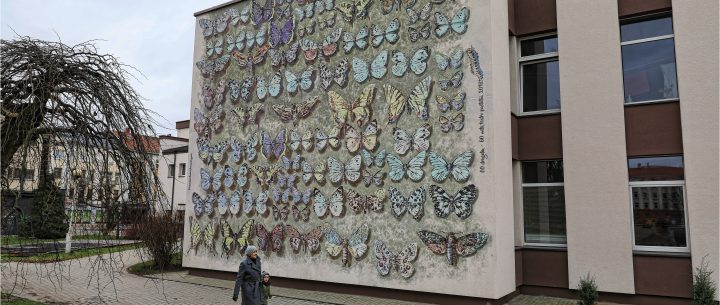Šiauliai streets tell their stories. Vasario 16-osios Street
The current Vasario 16-osios Street is one of the oldest in the city. It was marked in the city plan as early as in the 18 century and formed the eastern boundary of the marketplace. It was neighboured by the Nobility Court buildings that currently are part of the building of the city’s municipality. In the plan of 1852, the street seemed to be divided into two parts: the section from the church to the present Vilniaus Street was called Vilniaus and from Vilniaus Street, it was named Arklių Street. After the construction of Riga-Tilžė Highway and later, of the railway, this street shortened up to the current Vytauto Street.
When the County Police set up in the building next to the church, the street was called Policijos Street.
The German occupation authorities first used the name Polizei Strasse and later renamed it Bažnyčios Street (Kirchen Strasse) because the street abutted on the side of the church. In 1919, when the names were Lithuanianised, the street was called by both names.
From 1924, the name Bažnyčios Street was left. After the flight of pilots Darius and Girėnas, the street is given their name. In 1948, it is already called Gegužės 1-osios.
After the restoration of independence, the previous name Dariaus ir Girėno was not returned because such name was given to the street in Lieporiai residential area. Since 1989, it has been named Vasario 16-osios.
Šiauliai State Theatre
The issue of establishing a theatre in Šiauliai was repeatedly raised on April 28, 1929. At that time, the idea of organizing the theatre in the province was loudly discussed in Kaunas as well. The Society of Art Creators delegated the actor of the Kaunas State Theatre J. Stanulis and the artist A. Varnas to discuss this issue with the representatives of Šiauliai society (K. Šalkauskis, J. Sondeckis, J. Naujalis and P. Bugailiškis). At a meeting held in the premises of the city board, it was decided that the administrative and financial affairs of the future Šiauliai theatre would be taken care of by the established society to support the theatre, while the supervision of the artistic part would remain in the hands of the Society of Art Creators.
In 1931, the State Theatre directorate was instructed to establish its own branch in Šiauliai.
A wooden warehouse for theatrical scenery was attached to the Cinema Kapitol, adapting these premises to the drama theatre. On September 23, 1931, the Šiauliai branch of the Kaunas State Theatre raised the curtain. The theatre chose K. Gozzi’s fairy tale “Princess Turandot” directed by B. Dauguvietis for the opening.
Jonas Šliūpas
Jonas Šliūpas (1861-1944) – a doctor, writer for the newspaper Aušra, public figure. He organized the Lithuanian Association of Freethinkers and published the magazine Laisvoji mintis (Free thought). He actively participated in the activities of illegal Lithuanian press, organized during the press ban, and for some time edited the first Lithuanian newspaper Aušra. Went to the US, graduated with a degree in medicine. Upon his return to Lithuania in 1922, he
settled in Šiauliai. A year later, he opened a printing house here. From 1930, he established himself in Palanga. He was the first burgomaster of this city. In 1944, withdrew to Germany. There he died. In 1947, his ashes were transported to the Lithuanian National Cemetery in Chicago.
The printing house Titnagas was one of the most important and largest in the whole region of Samogitia.
It is no coincidence that Dr. J. Šliūpas chose the name Titnagas (Flint) for his printing house. By striking flint into the blade, Lithuanian peasants would obtain a spark to start fire and light. Fire and light are humanity’s greatest benefactors, without which life would be dark, dreary, and poor. Flint is a symbol of fight against darkness, of warmth, bliss, finally strength, hard and persistent work and fighting.
Šiauliai City Municipality
Šiauliai City Municipality is located in three historical buildings. One of them, in which the first Lithuanian performance was shown in 1904, was called Liaudies auditorija (the Folk Room) at that time. The building was opened in 1902. There was a hall accommodating 500 listeners, a tea house and a reading room. It was rented out for lectures, meetings, and performances.
During the press ban, when Lithuania was part of the Russian Empire, culture became a way to express resistance to Tsarism. In the last decade of the 19 century, secret so-called Lithuanian evening parties took place, which had become part of the national revival movement. In Šiauliai, they took place under the guise of gegužinės (public parties with music, dancing and singing outside), which from 1894 were held in Aleksandrija and other manors of the Zubovai. From 1899, gegužinės turned into gatherings of intelligentsia, in which, in addition to discussing relevant problems of public life of that time, concerts and performances took place.
On October 3, 1904, the Šiauliai Theatre lovers performed a comedy “Amerika pirtyje” (“America in the Bathhouse”).






Leave feedback